UC - Human Computer Interaction Design Review of TGE System
VerifiedAdded on 2023/06/13
|12
|2218
|360
Report
AI Summary
This document provides a comprehensive design review of the Travellers Great Experience (TGE) system, focusing on Human Computer Interaction principles. It includes an entity relationship diagram illustrating the database structure, highlighting relations that are not in normalized form and explaining the need for normalization to achieve 3NF. Data flow diagrams are used to elaborate on customer registration and package booking processes, detailing inputs, processes, and outputs. Use case diagrams model the interactions between customers and the system for booking and reviewing packages, while activity diagrams illustrate the workflow of these activities with swim lanes for customer, application, and database actions. The document also outlines plans for application development and deployment documentation, aiming to aid in system maintenance and user guidance. This report is submitted by a student at the University of Canberra, and similar solved assignments and resources are available on Desklib.
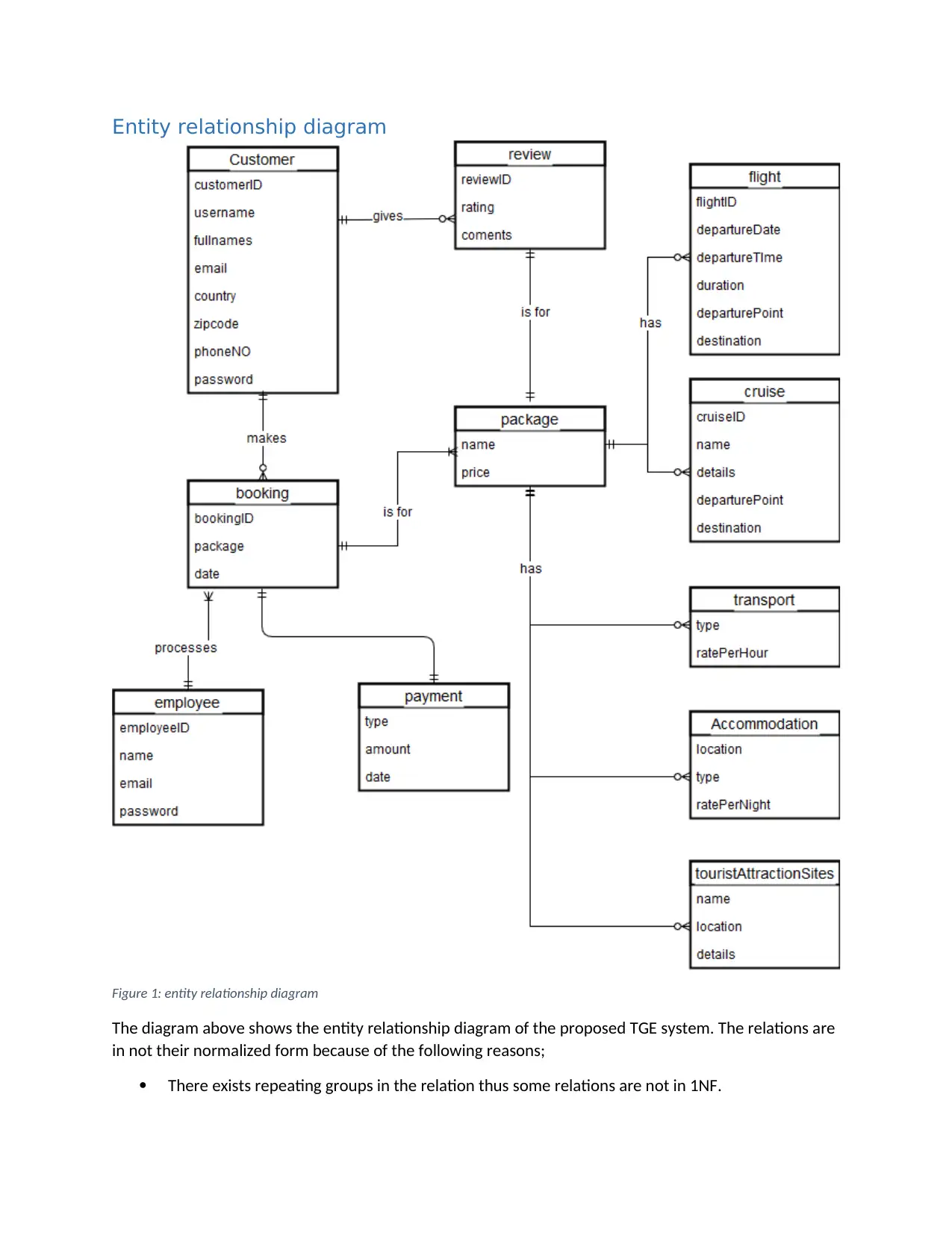
Entity relationship diagram
Figure 1: entity relationship diagram
The diagram above shows the entity relationship diagram of the proposed TGE system. The relations are
in not their normalized form because of the following reasons;
There exists repeating groups in the relation thus some relations are not in 1NF.
Figure 1: entity relationship diagram
The diagram above shows the entity relationship diagram of the proposed TGE system. The relations are
in not their normalized form because of the following reasons;
There exists repeating groups in the relation thus some relations are not in 1NF.
Paraphrase This Document
Need a fresh take? Get an instant paraphrase of this document with our AI Paraphraser
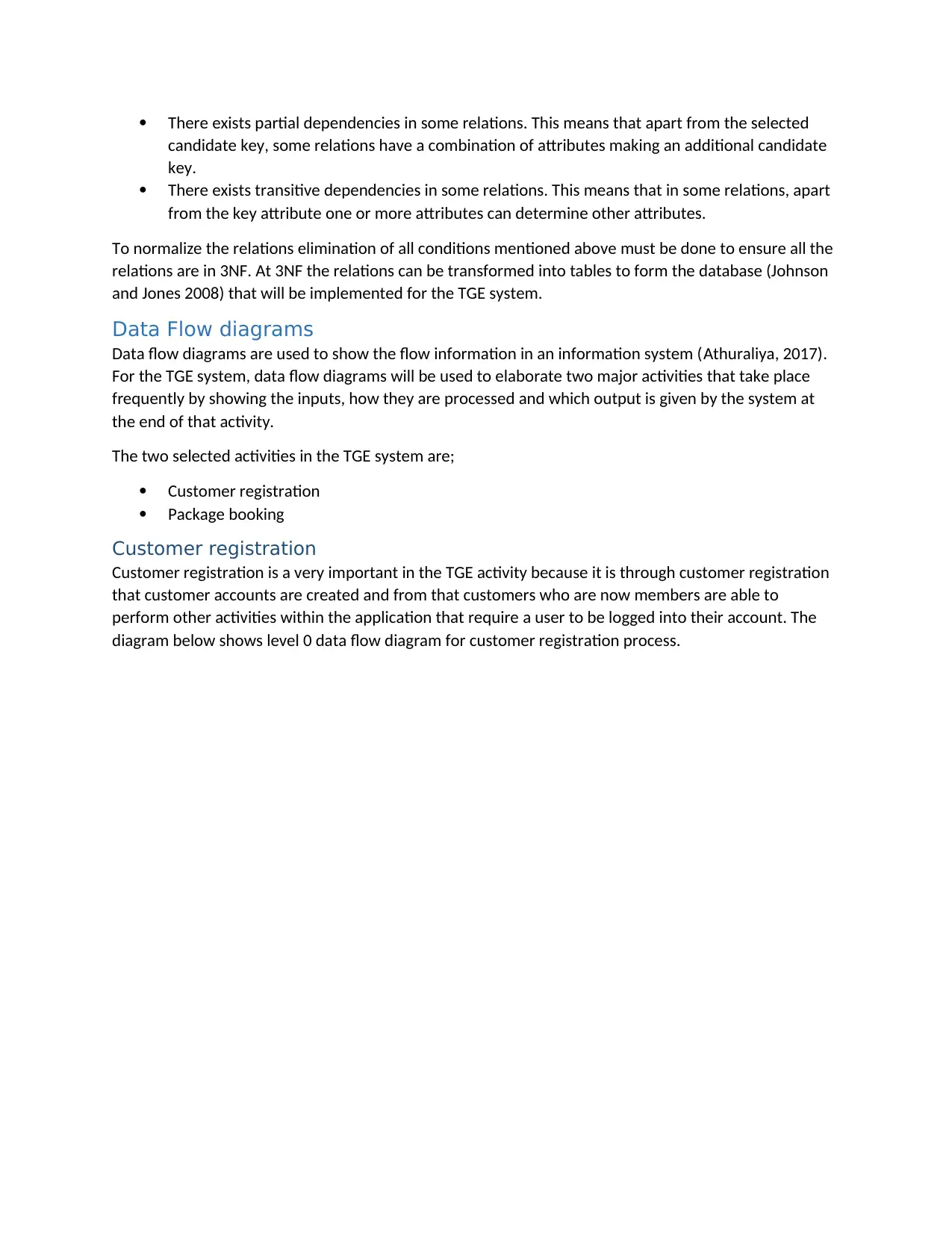
There exists partial dependencies in some relations. This means that apart from the selected
candidate key, some relations have a combination of attributes making an additional candidate
key.
There exists transitive dependencies in some relations. This means that in some relations, apart
from the key attribute one or more attributes can determine other attributes.
To normalize the relations elimination of all conditions mentioned above must be done to ensure all the
relations are in 3NF. At 3NF the relations can be transformed into tables to form the database (Johnson
and Jones 2008) that will be implemented for the TGE system.
Data Flow diagrams
Data flow diagrams are used to show the flow information in an information system (Athuraliya, 2017).
For the TGE system, data flow diagrams will be used to elaborate two major activities that take place
frequently by showing the inputs, how they are processed and which output is given by the system at
the end of that activity.
The two selected activities in the TGE system are;
Customer registration
Package booking
Customer registration
Customer registration is a very important in the TGE activity because it is through customer registration
that customer accounts are created and from that customers who are now members are able to
perform other activities within the application that require a user to be logged into their account. The
diagram below shows level 0 data flow diagram for customer registration process.
candidate key, some relations have a combination of attributes making an additional candidate
key.
There exists transitive dependencies in some relations. This means that in some relations, apart
from the key attribute one or more attributes can determine other attributes.
To normalize the relations elimination of all conditions mentioned above must be done to ensure all the
relations are in 3NF. At 3NF the relations can be transformed into tables to form the database (Johnson
and Jones 2008) that will be implemented for the TGE system.
Data Flow diagrams
Data flow diagrams are used to show the flow information in an information system (Athuraliya, 2017).
For the TGE system, data flow diagrams will be used to elaborate two major activities that take place
frequently by showing the inputs, how they are processed and which output is given by the system at
the end of that activity.
The two selected activities in the TGE system are;
Customer registration
Package booking
Customer registration
Customer registration is a very important in the TGE activity because it is through customer registration
that customer accounts are created and from that customers who are now members are able to
perform other activities within the application that require a user to be logged into their account. The
diagram below shows level 0 data flow diagram for customer registration process.
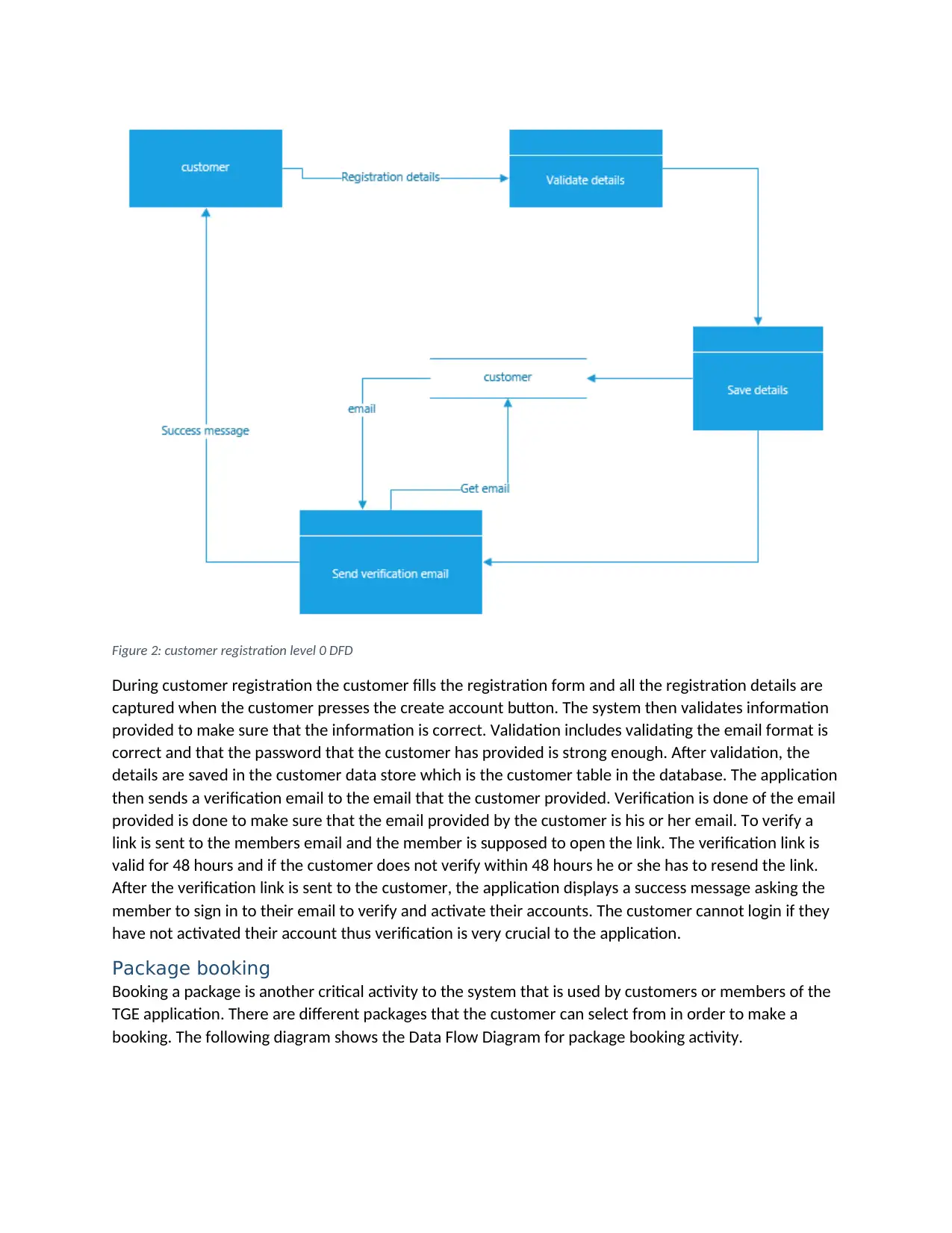
Figure 2: customer registration level 0 DFD
During customer registration the customer fills the registration form and all the registration details are
captured when the customer presses the create account button. The system then validates information
provided to make sure that the information is correct. Validation includes validating the email format is
correct and that the password that the customer has provided is strong enough. After validation, the
details are saved in the customer data store which is the customer table in the database. The application
then sends a verification email to the email that the customer provided. Verification is done of the email
provided is done to make sure that the email provided by the customer is his or her email. To verify a
link is sent to the members email and the member is supposed to open the link. The verification link is
valid for 48 hours and if the customer does not verify within 48 hours he or she has to resend the link.
After the verification link is sent to the customer, the application displays a success message asking the
member to sign in to their email to verify and activate their accounts. The customer cannot login if they
have not activated their account thus verification is very crucial to the application.
Package booking
Booking a package is another critical activity to the system that is used by customers or members of the
TGE application. There are different packages that the customer can select from in order to make a
booking. The following diagram shows the Data Flow Diagram for package booking activity.
During customer registration the customer fills the registration form and all the registration details are
captured when the customer presses the create account button. The system then validates information
provided to make sure that the information is correct. Validation includes validating the email format is
correct and that the password that the customer has provided is strong enough. After validation, the
details are saved in the customer data store which is the customer table in the database. The application
then sends a verification email to the email that the customer provided. Verification is done of the email
provided is done to make sure that the email provided by the customer is his or her email. To verify a
link is sent to the members email and the member is supposed to open the link. The verification link is
valid for 48 hours and if the customer does not verify within 48 hours he or she has to resend the link.
After the verification link is sent to the customer, the application displays a success message asking the
member to sign in to their email to verify and activate their accounts. The customer cannot login if they
have not activated their account thus verification is very crucial to the application.
Package booking
Booking a package is another critical activity to the system that is used by customers or members of the
TGE application. There are different packages that the customer can select from in order to make a
booking. The following diagram shows the Data Flow Diagram for package booking activity.
⊘ This is a preview!⊘
Do you want full access?
Subscribe today to unlock all pages.

Trusted by 1+ million students worldwide
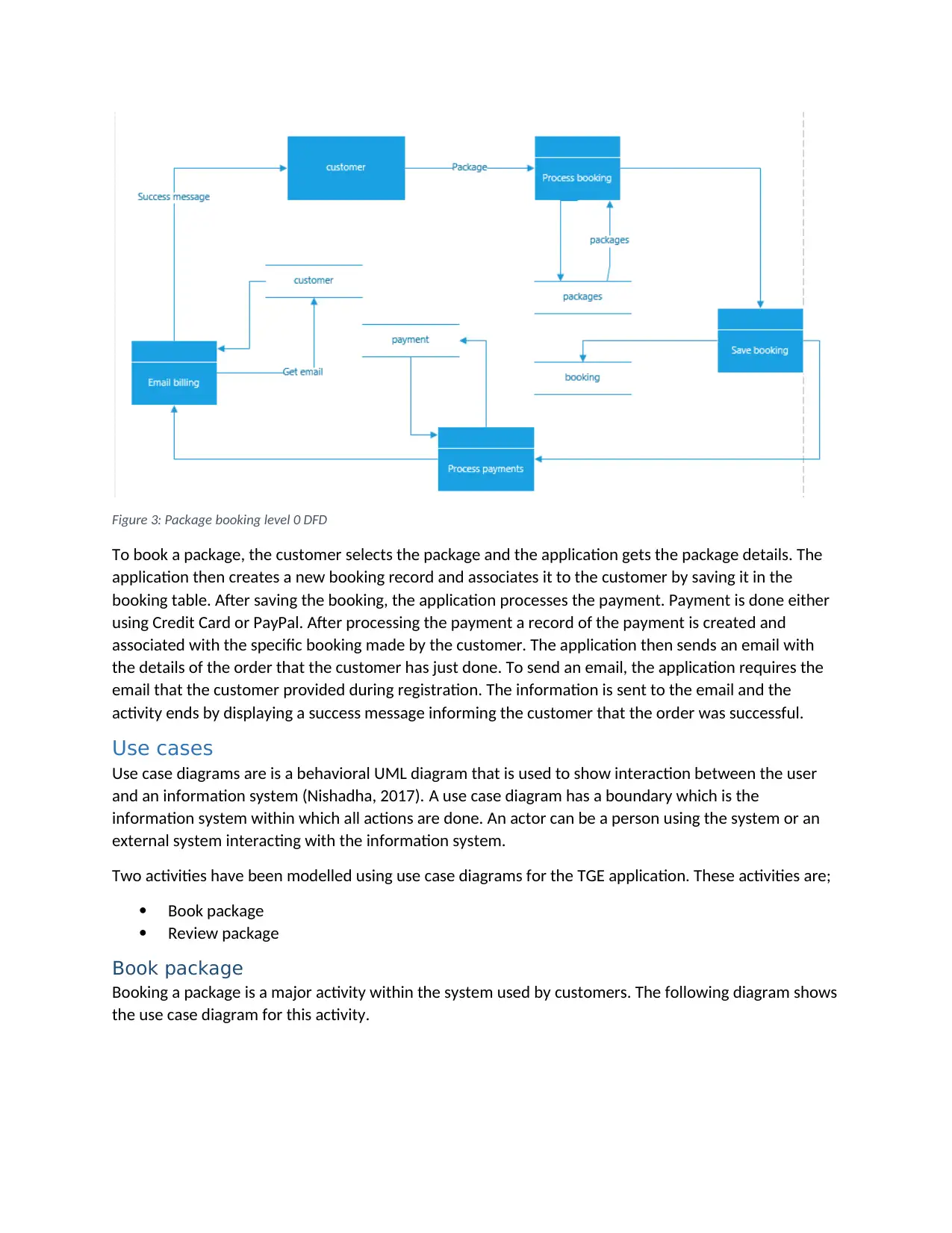
Figure 3: Package booking level 0 DFD
To book a package, the customer selects the package and the application gets the package details. The
application then creates a new booking record and associates it to the customer by saving it in the
booking table. After saving the booking, the application processes the payment. Payment is done either
using Credit Card or PayPal. After processing the payment a record of the payment is created and
associated with the specific booking made by the customer. The application then sends an email with
the details of the order that the customer has just done. To send an email, the application requires the
email that the customer provided during registration. The information is sent to the email and the
activity ends by displaying a success message informing the customer that the order was successful.
Use cases
Use case diagrams are is a behavioral UML diagram that is used to show interaction between the user
and an information system (Nishadha, 2017). A use case diagram has a boundary which is the
information system within which all actions are done. An actor can be a person using the system or an
external system interacting with the information system.
Two activities have been modelled using use case diagrams for the TGE application. These activities are;
Book package
Review package
Book package
Booking a package is a major activity within the system used by customers. The following diagram shows
the use case diagram for this activity.
To book a package, the customer selects the package and the application gets the package details. The
application then creates a new booking record and associates it to the customer by saving it in the
booking table. After saving the booking, the application processes the payment. Payment is done either
using Credit Card or PayPal. After processing the payment a record of the payment is created and
associated with the specific booking made by the customer. The application then sends an email with
the details of the order that the customer has just done. To send an email, the application requires the
email that the customer provided during registration. The information is sent to the email and the
activity ends by displaying a success message informing the customer that the order was successful.
Use cases
Use case diagrams are is a behavioral UML diagram that is used to show interaction between the user
and an information system (Nishadha, 2017). A use case diagram has a boundary which is the
information system within which all actions are done. An actor can be a person using the system or an
external system interacting with the information system.
Two activities have been modelled using use case diagrams for the TGE application. These activities are;
Book package
Review package
Book package
Booking a package is a major activity within the system used by customers. The following diagram shows
the use case diagram for this activity.
Paraphrase This Document
Need a fresh take? Get an instant paraphrase of this document with our AI Paraphraser
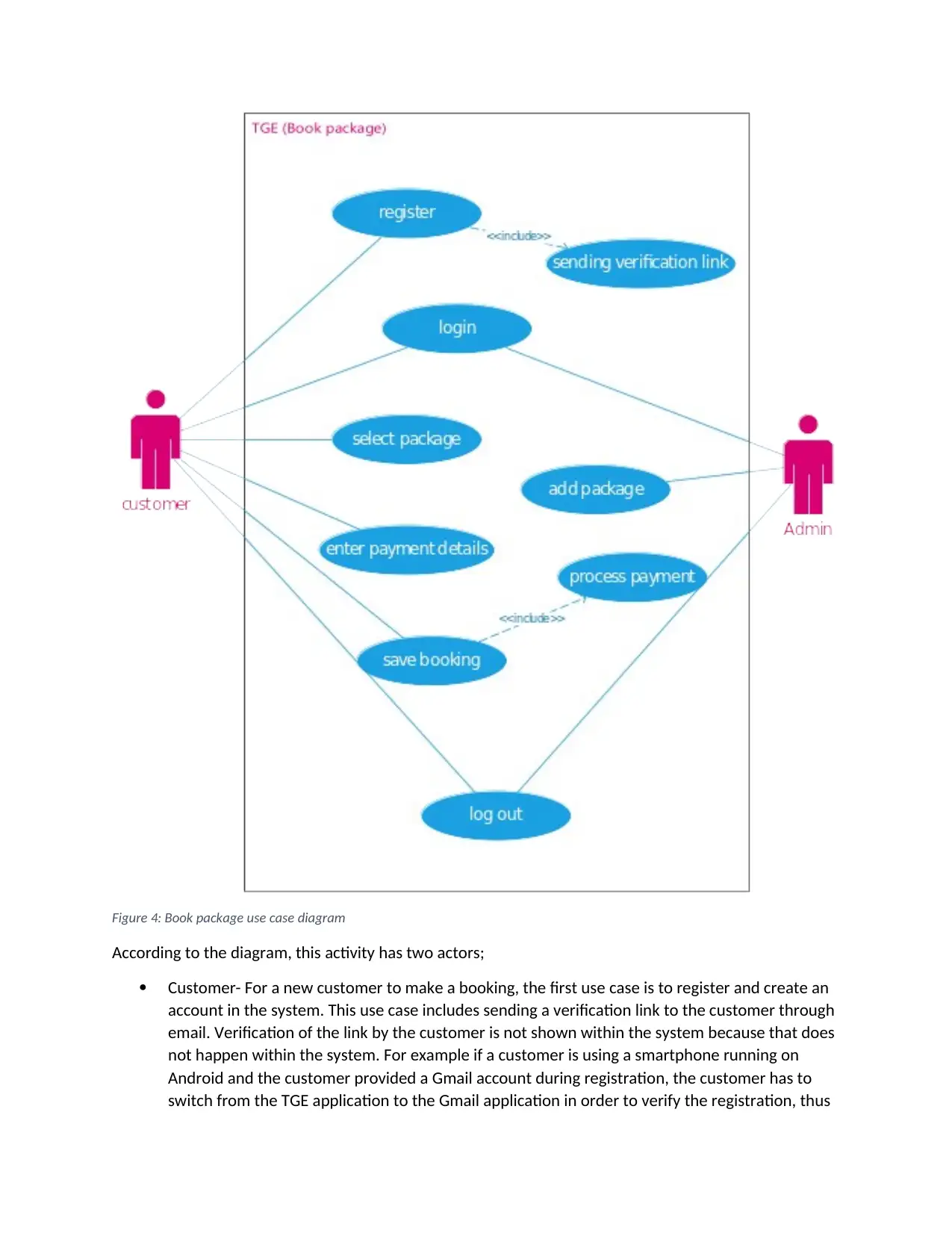
Figure 4: Book package use case diagram
According to the diagram, this activity has two actors;
Customer- For a new customer to make a booking, the first use case is to register and create an
account in the system. This use case includes sending a verification link to the customer through
email. Verification of the link by the customer is not shown within the system because that does
not happen within the system. For example if a customer is using a smartphone running on
Android and the customer provided a Gmail account during registration, the customer has to
switch from the TGE application to the Gmail application in order to verify the registration, thus
According to the diagram, this activity has two actors;
Customer- For a new customer to make a booking, the first use case is to register and create an
account in the system. This use case includes sending a verification link to the customer through
email. Verification of the link by the customer is not shown within the system because that does
not happen within the system. For example if a customer is using a smartphone running on
Android and the customer provided a Gmail account during registration, the customer has to
switch from the TGE application to the Gmail application in order to verify the registration, thus
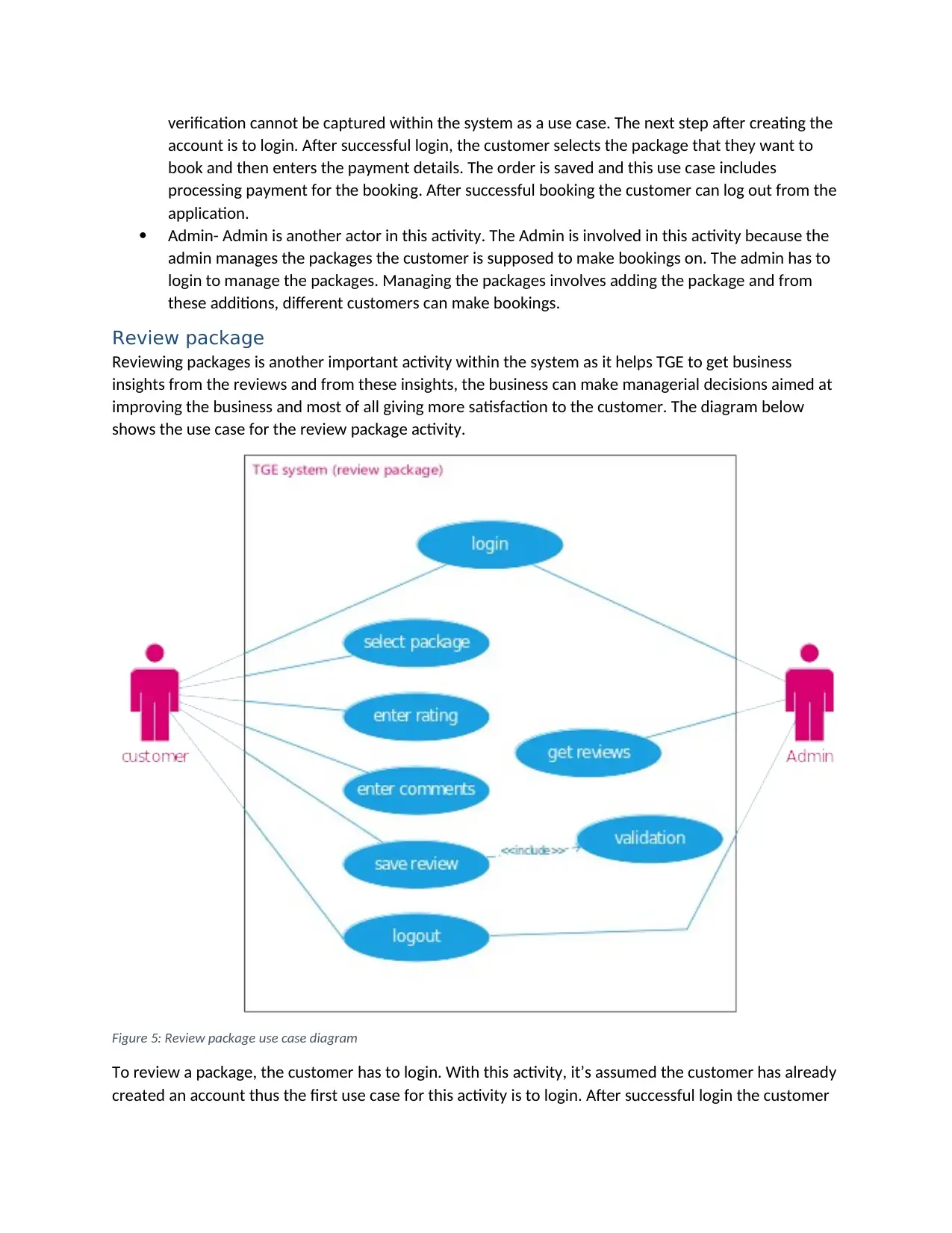
verification cannot be captured within the system as a use case. The next step after creating the
account is to login. After successful login, the customer selects the package that they want to
book and then enters the payment details. The order is saved and this use case includes
processing payment for the booking. After successful booking the customer can log out from the
application.
Admin- Admin is another actor in this activity. The Admin is involved in this activity because the
admin manages the packages the customer is supposed to make bookings on. The admin has to
login to manage the packages. Managing the packages involves adding the package and from
these additions, different customers can make bookings.
Review package
Reviewing packages is another important activity within the system as it helps TGE to get business
insights from the reviews and from these insights, the business can make managerial decisions aimed at
improving the business and most of all giving more satisfaction to the customer. The diagram below
shows the use case for the review package activity.
Figure 5: Review package use case diagram
To review a package, the customer has to login. With this activity, it’s assumed the customer has already
created an account thus the first use case for this activity is to login. After successful login the customer
account is to login. After successful login, the customer selects the package that they want to
book and then enters the payment details. The order is saved and this use case includes
processing payment for the booking. After successful booking the customer can log out from the
application.
Admin- Admin is another actor in this activity. The Admin is involved in this activity because the
admin manages the packages the customer is supposed to make bookings on. The admin has to
login to manage the packages. Managing the packages involves adding the package and from
these additions, different customers can make bookings.
Review package
Reviewing packages is another important activity within the system as it helps TGE to get business
insights from the reviews and from these insights, the business can make managerial decisions aimed at
improving the business and most of all giving more satisfaction to the customer. The diagram below
shows the use case for the review package activity.
Figure 5: Review package use case diagram
To review a package, the customer has to login. With this activity, it’s assumed the customer has already
created an account thus the first use case for this activity is to login. After successful login the customer
⊘ This is a preview!⊘
Do you want full access?
Subscribe today to unlock all pages.

Trusted by 1+ million students worldwide
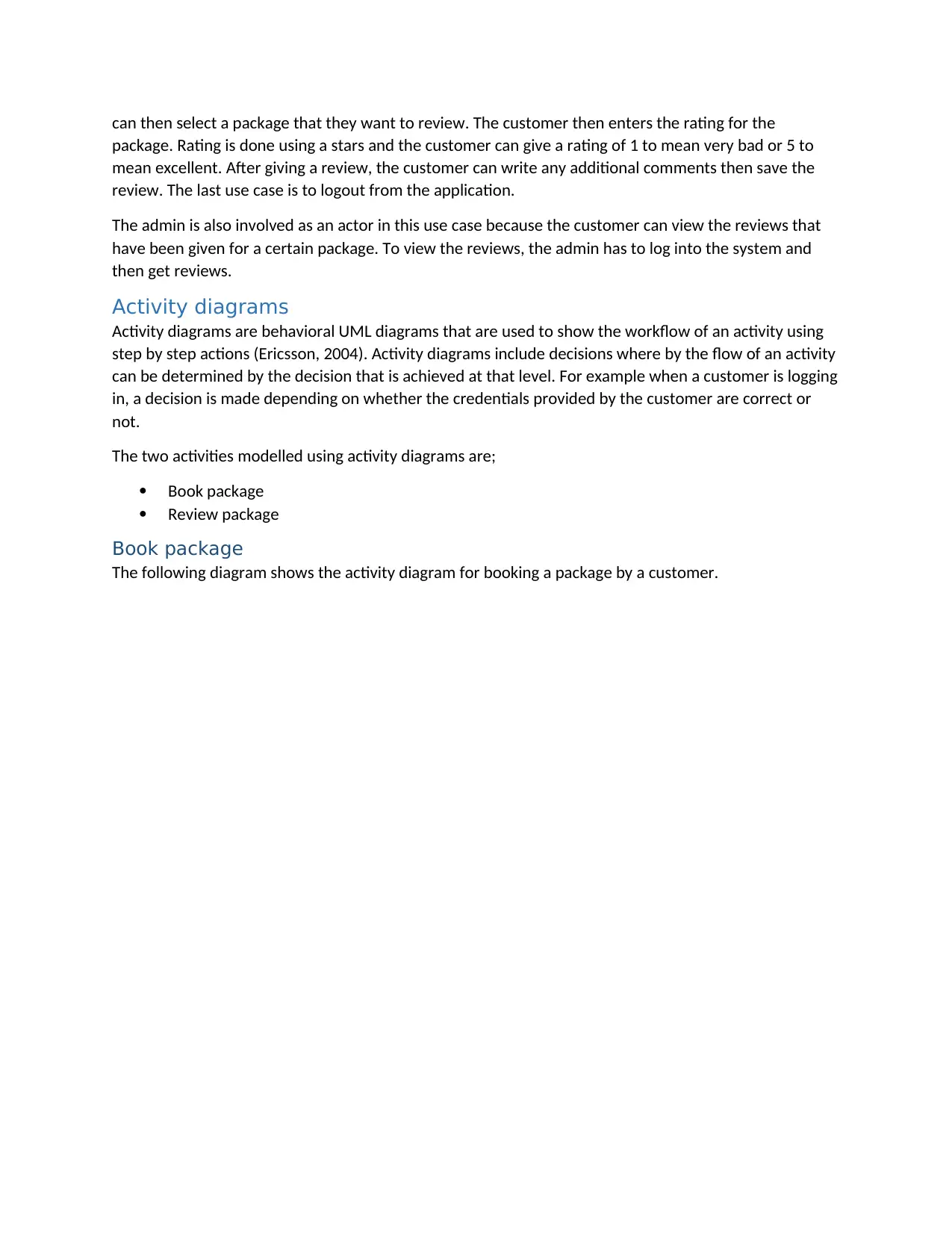
can then select a package that they want to review. The customer then enters the rating for the
package. Rating is done using a stars and the customer can give a rating of 1 to mean very bad or 5 to
mean excellent. After giving a review, the customer can write any additional comments then save the
review. The last use case is to logout from the application.
The admin is also involved as an actor in this use case because the customer can view the reviews that
have been given for a certain package. To view the reviews, the admin has to log into the system and
then get reviews.
Activity diagrams
Activity diagrams are behavioral UML diagrams that are used to show the workflow of an activity using
step by step actions (Ericsson, 2004). Activity diagrams include decisions where by the flow of an activity
can be determined by the decision that is achieved at that level. For example when a customer is logging
in, a decision is made depending on whether the credentials provided by the customer are correct or
not.
The two activities modelled using activity diagrams are;
Book package
Review package
Book package
The following diagram shows the activity diagram for booking a package by a customer.
package. Rating is done using a stars and the customer can give a rating of 1 to mean very bad or 5 to
mean excellent. After giving a review, the customer can write any additional comments then save the
review. The last use case is to logout from the application.
The admin is also involved as an actor in this use case because the customer can view the reviews that
have been given for a certain package. To view the reviews, the admin has to log into the system and
then get reviews.
Activity diagrams
Activity diagrams are behavioral UML diagrams that are used to show the workflow of an activity using
step by step actions (Ericsson, 2004). Activity diagrams include decisions where by the flow of an activity
can be determined by the decision that is achieved at that level. For example when a customer is logging
in, a decision is made depending on whether the credentials provided by the customer are correct or
not.
The two activities modelled using activity diagrams are;
Book package
Review package
Book package
The following diagram shows the activity diagram for booking a package by a customer.
Paraphrase This Document
Need a fresh take? Get an instant paraphrase of this document with our AI Paraphraser
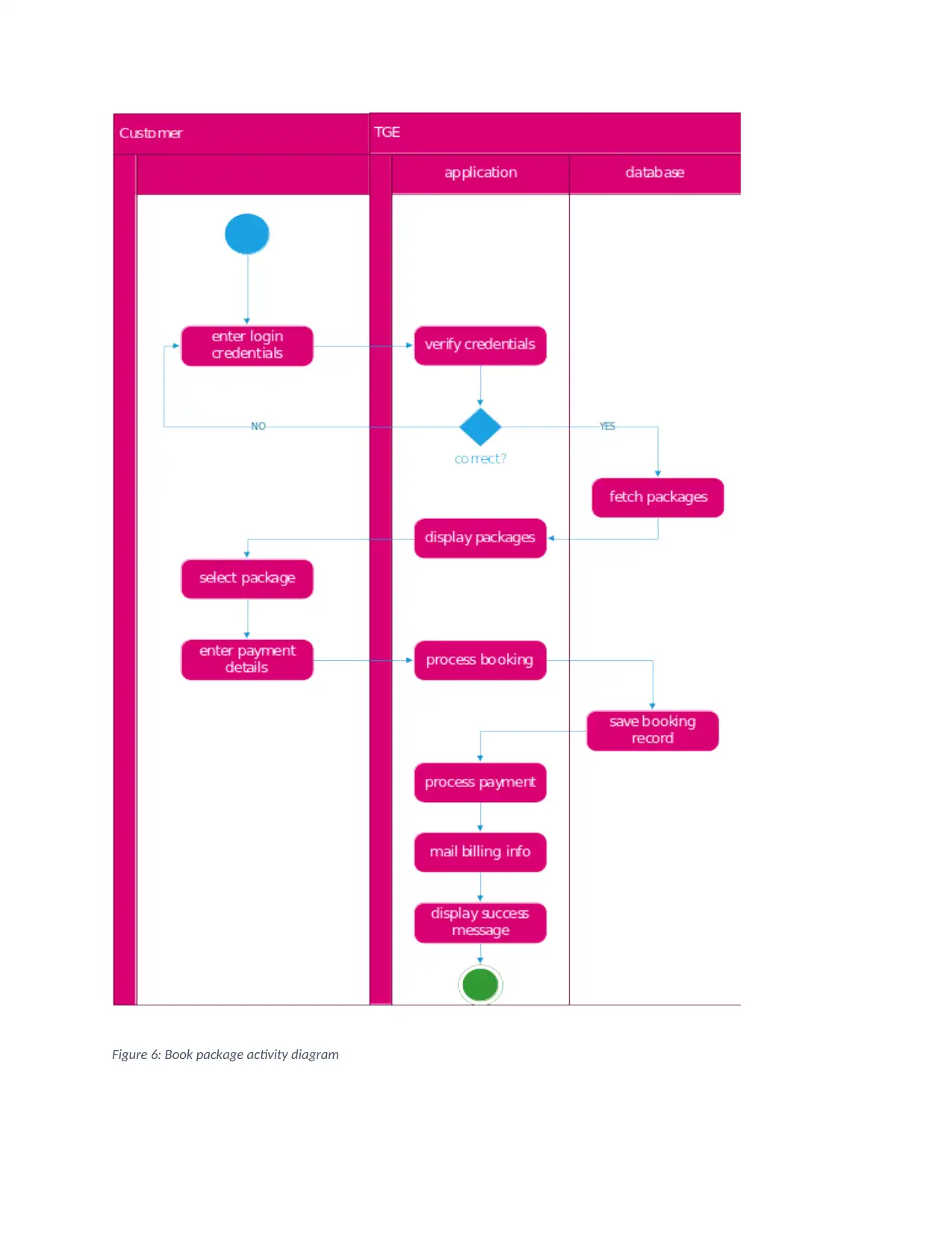
Figure 6: Book package activity diagram
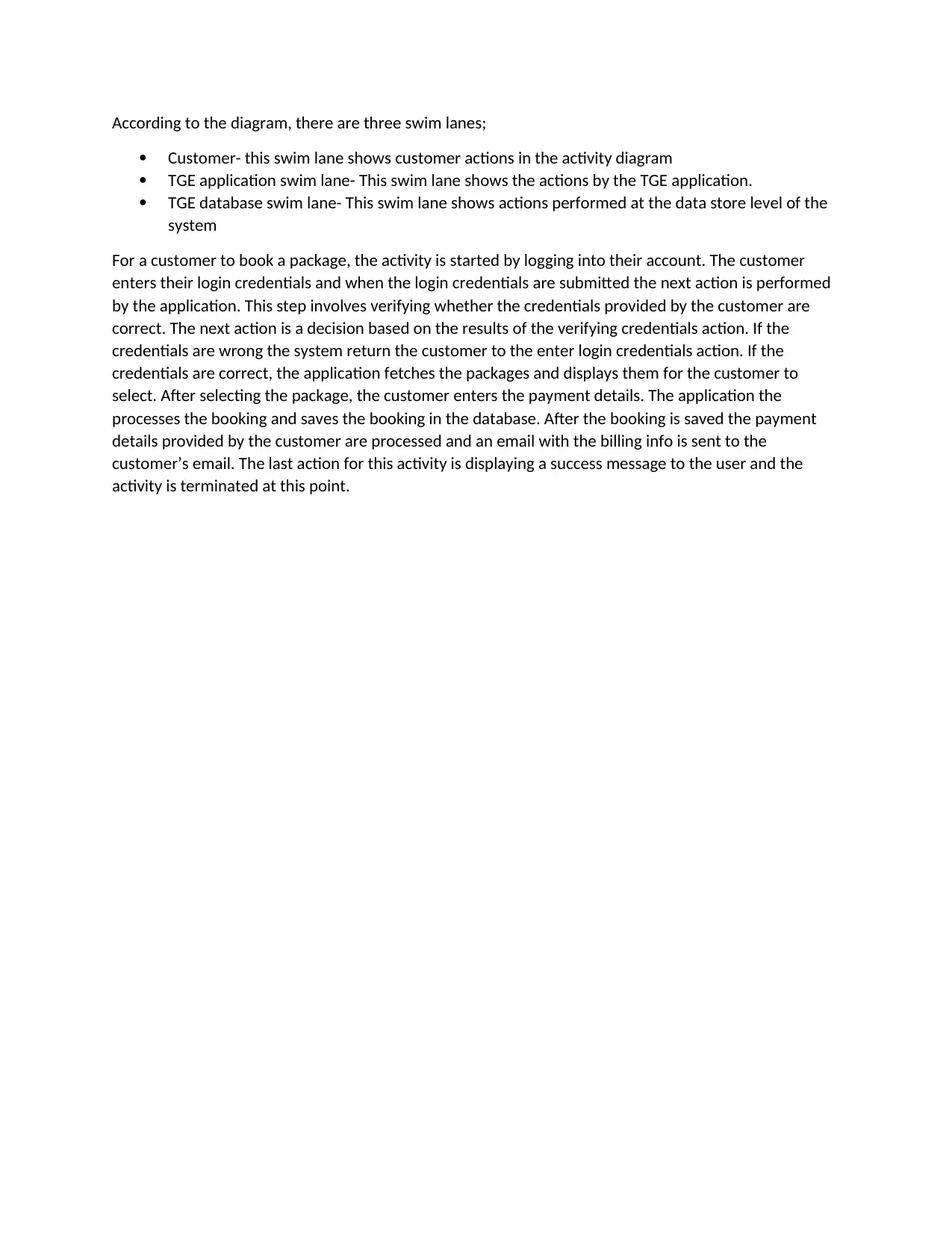
According to the diagram, there are three swim lanes;
Customer- this swim lane shows customer actions in the activity diagram
TGE application swim lane- This swim lane shows the actions by the TGE application.
TGE database swim lane- This swim lane shows actions performed at the data store level of the
system
For a customer to book a package, the activity is started by logging into their account. The customer
enters their login credentials and when the login credentials are submitted the next action is performed
by the application. This step involves verifying whether the credentials provided by the customer are
correct. The next action is a decision based on the results of the verifying credentials action. If the
credentials are wrong the system return the customer to the enter login credentials action. If the
credentials are correct, the application fetches the packages and displays them for the customer to
select. After selecting the package, the customer enters the payment details. The application the
processes the booking and saves the booking in the database. After the booking is saved the payment
details provided by the customer are processed and an email with the billing info is sent to the
customer’s email. The last action for this activity is displaying a success message to the user and the
activity is terminated at this point.
Customer- this swim lane shows customer actions in the activity diagram
TGE application swim lane- This swim lane shows the actions by the TGE application.
TGE database swim lane- This swim lane shows actions performed at the data store level of the
system
For a customer to book a package, the activity is started by logging into their account. The customer
enters their login credentials and when the login credentials are submitted the next action is performed
by the application. This step involves verifying whether the credentials provided by the customer are
correct. The next action is a decision based on the results of the verifying credentials action. If the
credentials are wrong the system return the customer to the enter login credentials action. If the
credentials are correct, the application fetches the packages and displays them for the customer to
select. After selecting the package, the customer enters the payment details. The application the
processes the booking and saves the booking in the database. After the booking is saved the payment
details provided by the customer are processed and an email with the billing info is sent to the
customer’s email. The last action for this activity is displaying a success message to the user and the
activity is terminated at this point.
⊘ This is a preview!⊘
Do you want full access?
Subscribe today to unlock all pages.

Trusted by 1+ million students worldwide
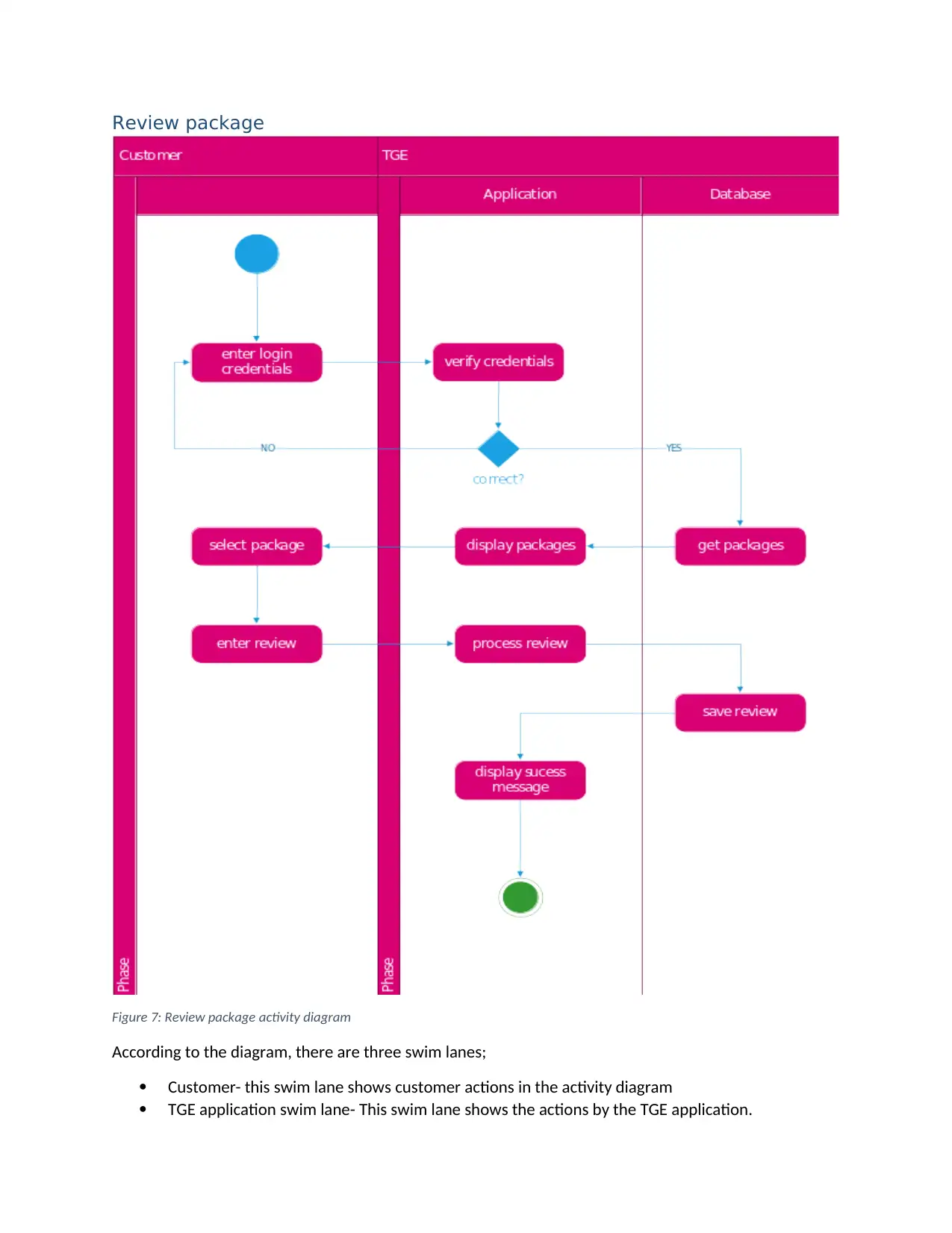
Review package
Figure 7: Review package activity diagram
According to the diagram, there are three swim lanes;
Customer- this swim lane shows customer actions in the activity diagram
TGE application swim lane- This swim lane shows the actions by the TGE application.
Figure 7: Review package activity diagram
According to the diagram, there are three swim lanes;
Customer- this swim lane shows customer actions in the activity diagram
TGE application swim lane- This swim lane shows the actions by the TGE application.
Paraphrase This Document
Need a fresh take? Get an instant paraphrase of this document with our AI Paraphraser
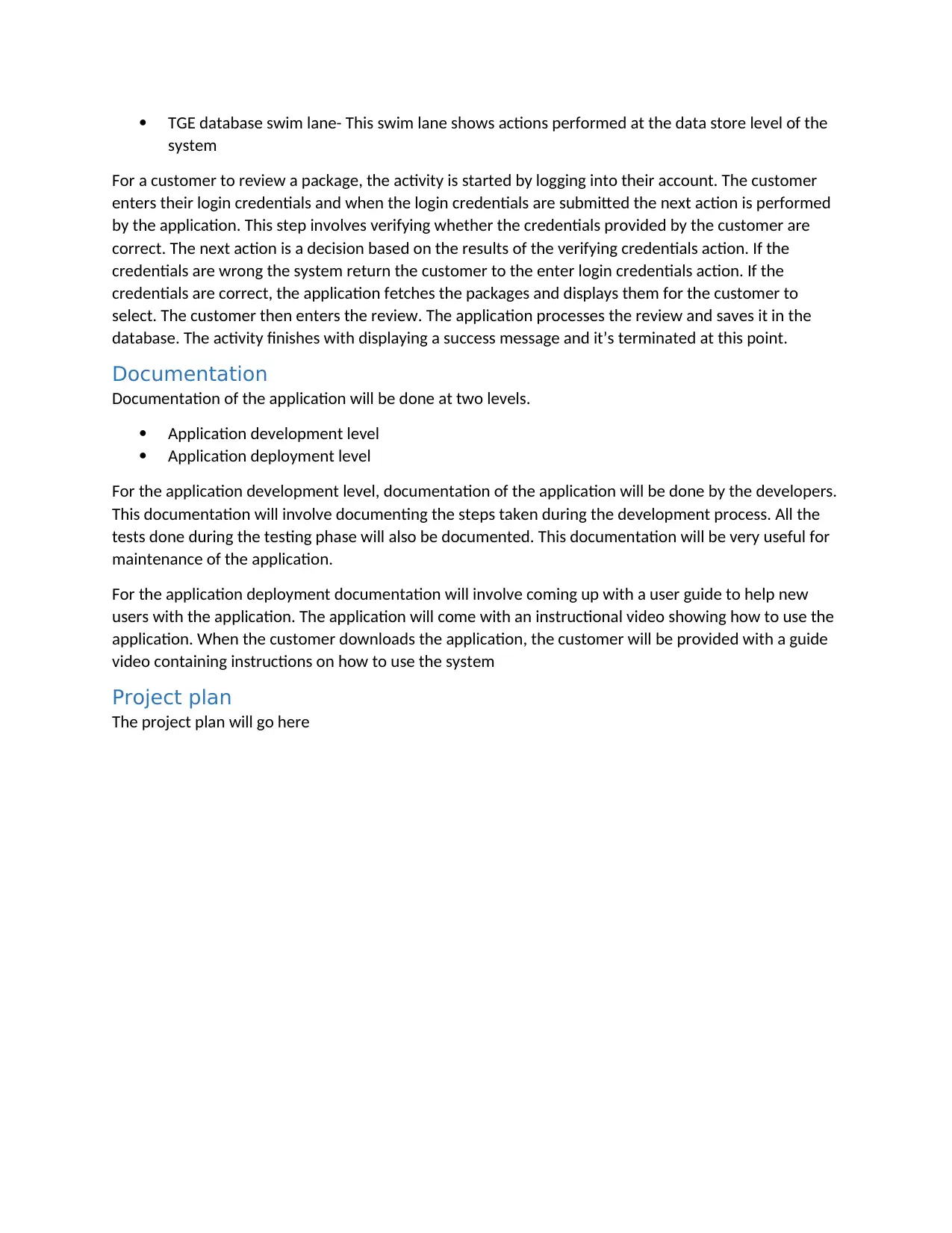
TGE database swim lane- This swim lane shows actions performed at the data store level of the
system
For a customer to review a package, the activity is started by logging into their account. The customer
enters their login credentials and when the login credentials are submitted the next action is performed
by the application. This step involves verifying whether the credentials provided by the customer are
correct. The next action is a decision based on the results of the verifying credentials action. If the
credentials are wrong the system return the customer to the enter login credentials action. If the
credentials are correct, the application fetches the packages and displays them for the customer to
select. The customer then enters the review. The application processes the review and saves it in the
database. The activity finishes with displaying a success message and it’s terminated at this point.
Documentation
Documentation of the application will be done at two levels.
Application development level
Application deployment level
For the application development level, documentation of the application will be done by the developers.
This documentation will involve documenting the steps taken during the development process. All the
tests done during the testing phase will also be documented. This documentation will be very useful for
maintenance of the application.
For the application deployment documentation will involve coming up with a user guide to help new
users with the application. The application will come with an instructional video showing how to use the
application. When the customer downloads the application, the customer will be provided with a guide
video containing instructions on how to use the system
Project plan
The project plan will go here
system
For a customer to review a package, the activity is started by logging into their account. The customer
enters their login credentials and when the login credentials are submitted the next action is performed
by the application. This step involves verifying whether the credentials provided by the customer are
correct. The next action is a decision based on the results of the verifying credentials action. If the
credentials are wrong the system return the customer to the enter login credentials action. If the
credentials are correct, the application fetches the packages and displays them for the customer to
select. The customer then enters the review. The application processes the review and saves it in the
database. The activity finishes with displaying a success message and it’s terminated at this point.
Documentation
Documentation of the application will be done at two levels.
Application development level
Application deployment level
For the application development level, documentation of the application will be done by the developers.
This documentation will involve documenting the steps taken during the development process. All the
tests done during the testing phase will also be documented. This documentation will be very useful for
maintenance of the application.
For the application deployment documentation will involve coming up with a user guide to help new
users with the application. The application will come with an instructional video showing how to use the
application. When the customer downloads the application, the customer will be provided with a guide
video containing instructions on how to use the system
Project plan
The project plan will go here
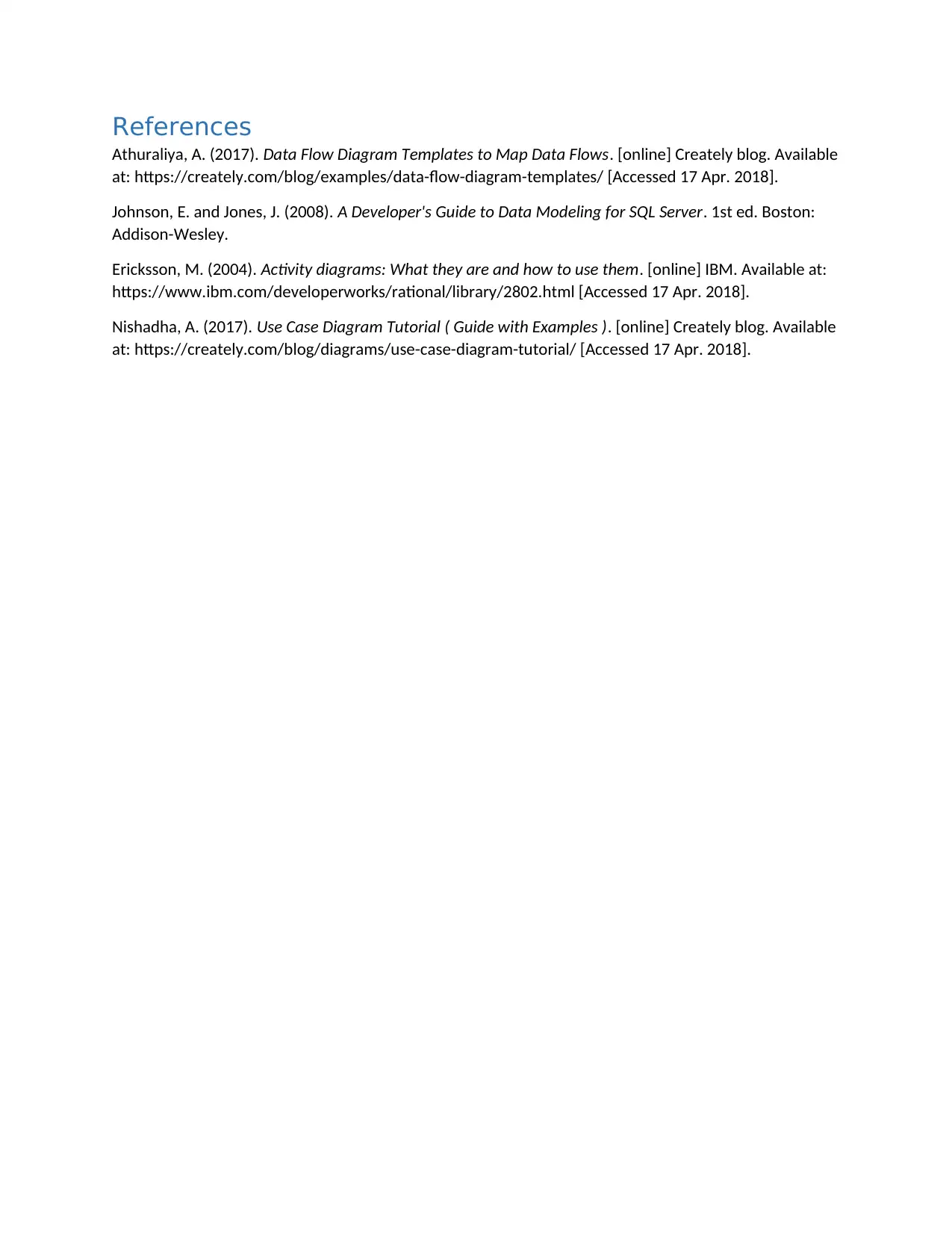
References
Athuraliya, A. (2017). Data Flow Diagram Templates to Map Data Flows. [online] Creately blog. Available
at: https://creately.com/blog/examples/data-flow-diagram-templates/ [Accessed 17 Apr. 2018].
Johnson, E. and Jones, J. (2008). A Developer's Guide to Data Modeling for SQL Server. 1st ed. Boston:
Addison-Wesley.
Ericksson, M. (2004). Activity diagrams: What they are and how to use them. [online] IBM. Available at:
https://www.ibm.com/developerworks/rational/library/2802.html [Accessed 17 Apr. 2018].
Nishadha, A. (2017). Use Case Diagram Tutorial ( Guide with Examples ). [online] Creately blog. Available
at: https://creately.com/blog/diagrams/use-case-diagram-tutorial/ [Accessed 17 Apr. 2018].
Athuraliya, A. (2017). Data Flow Diagram Templates to Map Data Flows. [online] Creately blog. Available
at: https://creately.com/blog/examples/data-flow-diagram-templates/ [Accessed 17 Apr. 2018].
Johnson, E. and Jones, J. (2008). A Developer's Guide to Data Modeling for SQL Server. 1st ed. Boston:
Addison-Wesley.
Ericksson, M. (2004). Activity diagrams: What they are and how to use them. [online] IBM. Available at:
https://www.ibm.com/developerworks/rational/library/2802.html [Accessed 17 Apr. 2018].
Nishadha, A. (2017). Use Case Diagram Tutorial ( Guide with Examples ). [online] Creately blog. Available
at: https://creately.com/blog/diagrams/use-case-diagram-tutorial/ [Accessed 17 Apr. 2018].
⊘ This is a preview!⊘
Do you want full access?
Subscribe today to unlock all pages.

Trusted by 1+ million students worldwide
1 out of 12
Related Documents
Your All-in-One AI-Powered Toolkit for Academic Success.
+13062052269
info@desklib.com
Available 24*7 on WhatsApp / Email
![[object Object]](/_next/static/media/star-bottom.7253800d.svg)
Unlock your academic potential
Copyright © 2020–2025 A2Z Services. All Rights Reserved. Developed and managed by ZUCOL.





